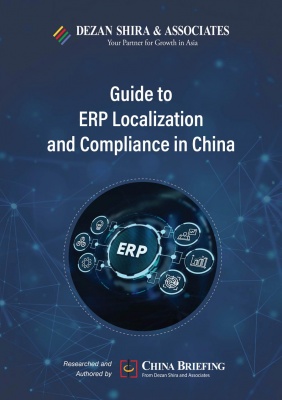
Guide to ERP Localization and Compliance in China
Published: April 2024For international companies operating in China, the decision to adopt or localize an Enterprise Resource Planning (ERP) system holds significant strategic implications. This ERP handbook examines how businesses can successfully select, configure, and implement ERP systems for a China operation. Its sections issues for consideration such as the pros and cons of different ERP paths, the importance of making local configurations when expanding global ERP to China, as well as common pitfalls and corresponding tips that business leaders should pay attention to during the ERP implementation process.
For international companies operating in China, the decision to adopt or localize an Enterprise Resource Planning (ERP) system holds significant strategic implications. This choice serves as a critical tool for achieving enhanced operational control, effectively addressing market uncertainties, and driving organizational efficiencies.
The landscape of doing business in China has undergone significant transformations since the onset of the COVID-19 pandemic. On one hand, international firms operating in China benefit from unparalleled access to one of the world’s largest markets and the most competitive global supply chains. However, these companies also grapple with new challenges, such as an uneven economic recovery, shifts in Asia’s supply chain resources and manufacturing bases, geopolitical risks, and evolving tax and data compliance regulations both in China and abroad.
Despite these complexities, informed executives discover substantial opportunities to enhance and leverage their comparative advantage by optimizing operations within the country. Simultaneously, they must navigate an increasingly intricate environment to ensure compliance, streamline costs, and effectively manage risks both internally and externally.
Given this context, ERP systems have gained significant favor among international companies operating in China. These systems serve as essential tools for optimizing operations, enhancing internal controls, and fortifying supply chain resilience. Moreover, they offer a host of advantages to organizations seeking to scale their presence and expand operations within the region.
That said, the prospect of ERP localization or adoption in China bears unique challenges. Successful ERP planning and implementation hinges on a strong understanding of the local business, cultural, and technology context, cultivating precise expectations and, and executing a well-formed plan with the enlisted support of a capable and rounded ERP integration and localization expert. Employing shrewd end-user strategies that suit your business local needs and culture is also key to unleashing the system’s transformative potential for your firm.
Prepared for the operations, finance and technology executives, and department leaders of companies operating in China, this ERP handbook by Dezan Shira & Associates examines how businesses can successfully select, configure, and implement ERP systems for a China operation. Its sections explore common drivers behind a company’s push to move to ERP in China, and important issues for consideration such as the pros and cons of different ERP paths, the importance of making local configurations when expanding global ERP to China, as well as common pitfalls and corresponding tips that business leaders should pay attention to during the ERP implementation process.
In this guide:
- What is ERP?
- Why is ERP Important for Operating a China Business?
- Choosing a Suitable Path to ERP for Your China Business
- How to Localize Your Global ERP to China?
- How to Ensure Successful ERP Implementation in China?

